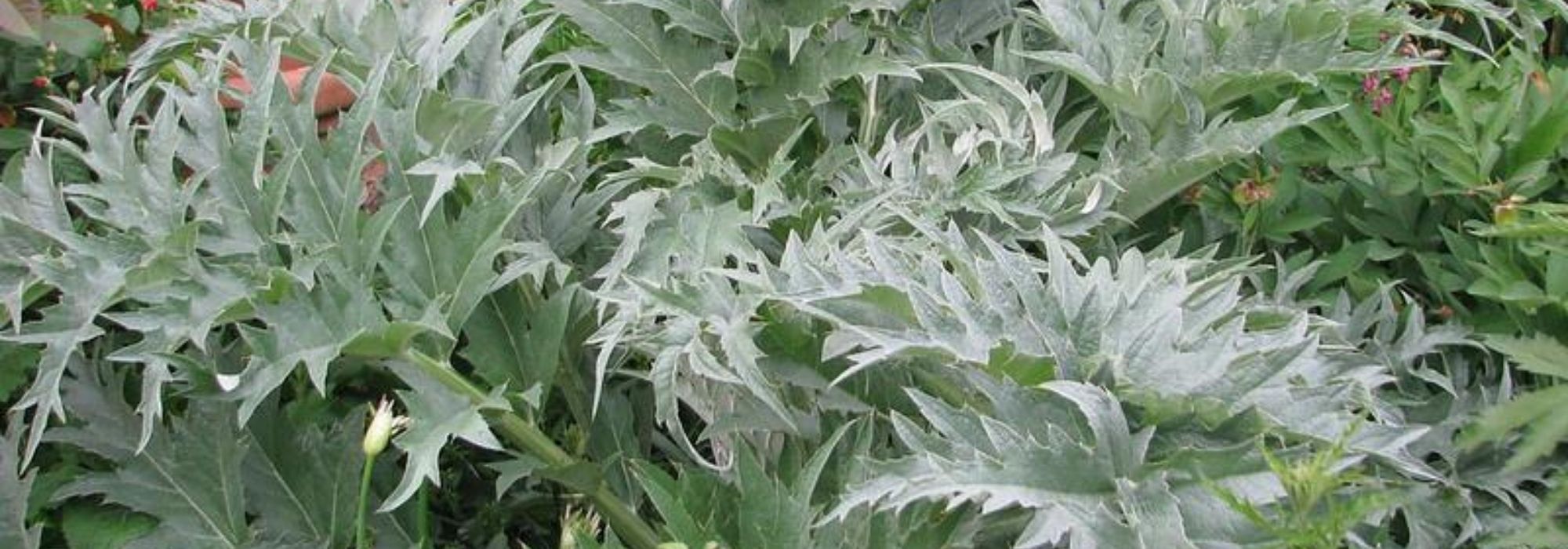
Cardoon: planting, growing, harvest
Contents
Cardoon in a nutshell
- Cardoon is a vegetable with a slightly bitter taste, similar to artichoke
- It is grown for the fleshy midribs of its foliage, which are edible and tasty once blanched
- Its highly dissected foliage, grey-blue or silver in colour, is very characteristic and ornamental
- In summer, its flowering produces stunning small artichoke-like flowers, with bright violet-blue hues
- It is easy to grow in full sun, in any good garden soil
A word from our expert
Cardoon (Cynara cardunculus) is a majestic vegetable plant that forms large clumps of deeply lobed leaves with fleshy midribs, known as cardes. Unjustly forgotten, cardoon reveals a taste similar to that of its cousin, the artichoke, with an additional hint of bitterness.
Cardoon is sometimes confused with Swiss chard; however, unlike the latter, its leaves are not edible: it is the midribs that are sought after and, once blanched, lend themselves to numerous recipes. They can be prepared in a thousand and one ways, particularly in gratins, with pith in Lyon, or simply as a side dish for meat.
It is said that there is no good cardoon without thorns; indeed, two types of cardoons can be distinguished: the thorny cardoons, with full midribs that are very tasty, such as ‘Silver Spiny of Plainpalais’, and the inermous varieties that are conveniently thornless, like the ‘Spineless Full White Cardoon’.
Today, to make our lives easier, there are even varieties that naturally blanch.
It’s all a matter of taste! Whether thorny like the wild cardoon or inermous, it is an easy vegetable to grow in the vegetable garden, in the sun, in rich, cool, well-drained soil.
Its imposing, lobed foliage and flowering in large upright purple thistles will also add a very architectural touch to the ornamental garden.
We invite you to discover the most beautiful varieties in the form of seeds or young plants!
Description and botany
Botanical data
- Latin name Cynara cardunculus
- Family Asteraceae
- Common name Cardoon
- Flowering June-July
- Height 0.60 to 2 m
- Exposure Sun
- Soil type rich and moist
- Hardiness -7 to -10°C
The Cardoon – Cynara cardunculus – is a vegetable plant from the Asteraceae family (like artichoke, lettuce, or sunflower). Native to the Mediterranean basin, it can be found from Portugal and Spain to Italy, Greece, and North Africa. In France, it grows spontaneously on arid slopes and along paths in certain regions, notably Gard, Hérault, Aude, Pyrénées-Orientales, and Corsica.
The term cardoon derives from the Occitan word “chardon”, which is another cousin in the family, of which it is a giant form. The genus includes about ten species. Two types of cardoons are distinguished:
- spiny varieties with very tasty solid ribs such as the ‘cardon de Plainpalais’ classified as AOC
- inermous varieties that are very slightly spiny, with hollower ribs such as the ‘Spineless Full White Cardoon’, the most cultivated variety, ‘Improved White Cardoon’, ‘Improved Full White Puvis’, or ‘Red Cardoon from Algiers’
Today, the cultivation of cardoon mainly focuses on non-spiny varieties.
While cardoon and artichoke (Cynara cardunculus var. scolymus) are considered two horticultural varieties of wild cardoon, they differ in that artichoke is cultivated for its flower bud, whereas cardoon is grown for its ribs.
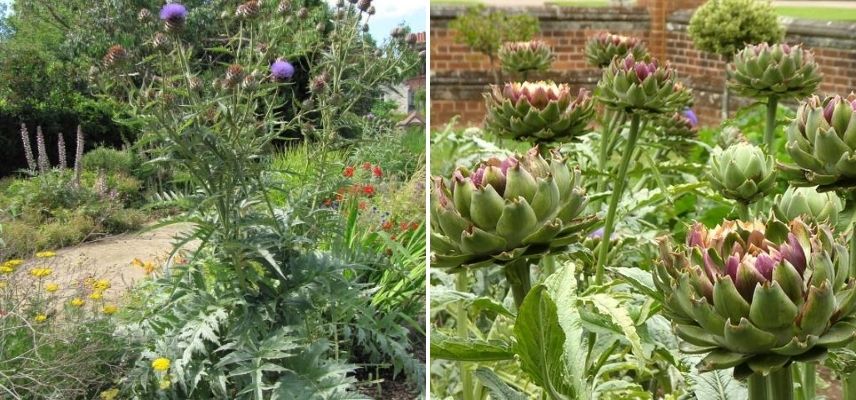 Cardoons enhance both ornamental and vegetable gardens with the same natural charm.
Cardoons enhance both ornamental and vegetable gardens with the same natural charm.
The cardoon forms a very large, spreading tuft, composed of rosettes of leaves that can reach 2 m in height and 1.50 m in width at maturity. The highly dissected foliage is very characteristic and ornamental.
The spectacularly sized leaves, reaching up to 1 m long and 30 to 60 cm wide, are opposite, strongly veined, and deeply lobed with pointed tips, undulating, and sometimes arching. Grey-green or grey-blue on the upper side, they have a tomentose underside. Depending on the species, they may be covered in sharp thorns or be inermous, meaning thornless. They are borne by large fleshy petioles that are greenish-white, called ribs or “côtes”, which extend into the central vein of the foliage. It is these ribs of cardoon or cardes that are consumed once blanched. All contain a milky sap with a bitter taste that blanching removes.
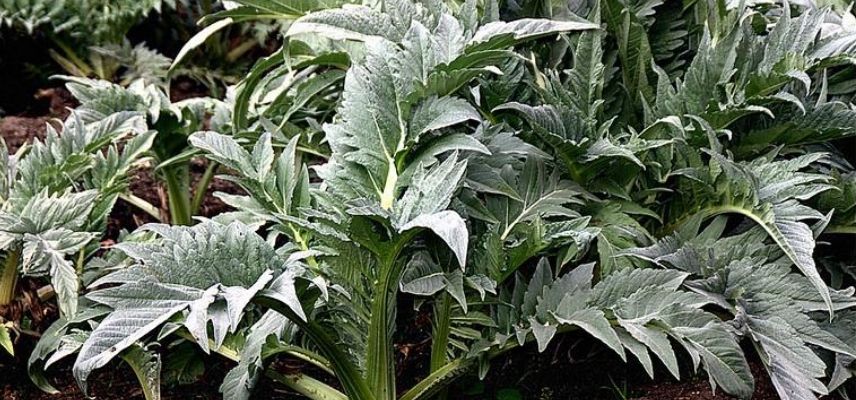 The characteristic leaves of the cardoon: very lobed and greyish reflections.
The characteristic leaves of the cardoon: very lobed and greyish reflections.
In June-July of the second year of cultivation, flowering resembling thistles emerges from this imposing tuft of large leaves. It appears in large solitary heads borne at the top of robust, branched stems. These bulbous-shaped corollas consist of several rows of feathery hairs in indigo to violet, housed in a fleshy, scaly receptacle made of tough, spiny or non-spiny involucral bracts. These flower buds, resembling mini-artichokes 5 cm in diameter, are edible.
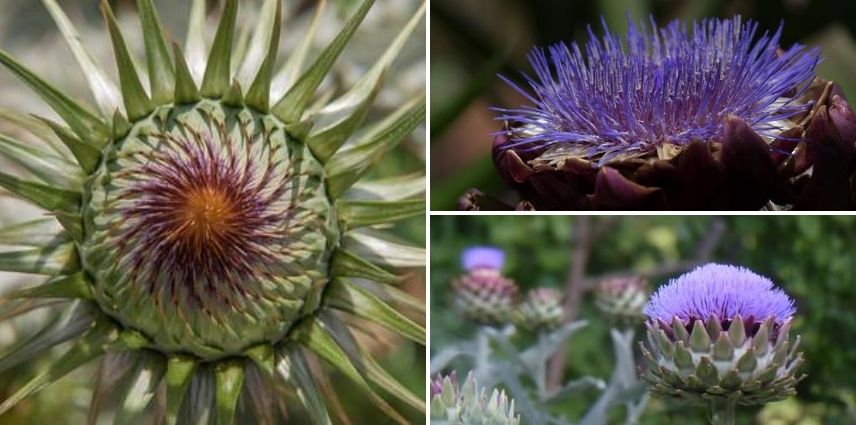 Extraordinary graphic design of the flower in full bloom in the middle of summer!
Extraordinary graphic design of the flower in full bloom in the middle of summer!
Cardoon flowers create original bouquets and are very graphic once dried in a vase.
Highly nectariferous, they develop into seeds once fertilised by insects, which readily self-seed (sometimes even invasively) to produce a flowering plant in 2 to 3 years.
Cardoon gratin is a specialty traditionally served in Provence or the Lyon region at Christmas.
Read also
Conserver les légumes du potagerMain species and varieties
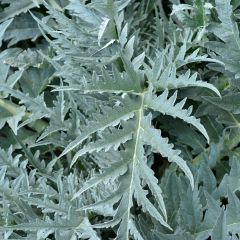
Cynara cardunculus improved white-flowered - cardoon seeds
- Flowering time August to October
- Height at maturity 1,30 m
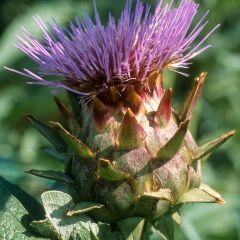
Cardoon Spineless Full White - Cynara cardunculus
- Flowering time August to October
- Height at maturity 1,75 m
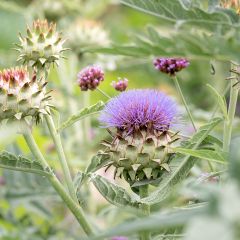
Potted Cynara cardunculus - Cardoon
- Flowering time July to September
- Height at maturity 1,50 m
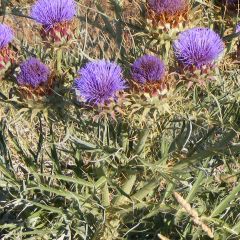
Cardoon D'Alger - Cynara cardunculus
- Flowering time August to October
- Height at maturity 1,75 m
Discover other Cardoon seeds
View all →Available in 1 sizes
Available in 1 sizes
Available in 1 sizes
Available in 1 sizes
Planting the artichoke thistle
Where to plant it?
Native to the Mediterranean, cardoon is a plant of medium hardiness, tolerating temperatures from -7°C to -10°C, and is generally grown as an annual or biennial. It thrives in rich, fresh, well-drained soil, preferably in full sun. It dislikes wet and waterlogged soils. If your soil retains water, especially in winter, we recommend planting it on a mound to improve drainage and adding some coarse sand or gravel to the garden soil.
The cardoon forms robust, dense clumps that are very ornamental: allocate a space that matches its impressive growth as it tends to overshadow its neighbours. Protect it from strong winds.
While this beautiful plant naturally finds its place in a vegetable garden, its architectural presence is always very striking in the garden. It deserves more than a spot in the vegetable patch and will also serve as a spectacular focal point in a large bed of perennials or annuals, providing verticality and striking volume.
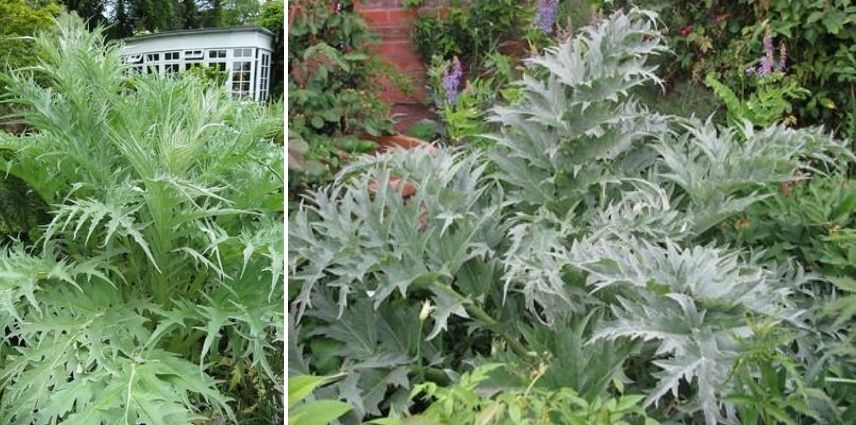 The exuberance and originality of cardoons make them spectacular in gardens!
The exuberance and originality of cardoons make them spectacular in gardens!
When to plant it?
Plant your cardoon in a pot after the last severe frosts, from March to May depending on the region. Autumn planting is also possible to encourage rooting before winter.
How to plant it?
Maintain a distance of about 80 cm to 1 m at least in all directions so that the plant can develop well.
- Dig a hole three times the volume of the root ball
- Place the root ball and cover it with well-crumbled soil mixed with some mature compost
- Firm the soil and water to keep it moist
- Water at the base regularly to aid recovery but avoid excess
- Mulch to keep the soil cool in summer
→ Read also: Grow the cardoon, a vegetable with tasty ribs.
Sowing of cardoon
When and how to sow?
Sowing under cover
Sowing can be done in trays or pots under a cold greenhouse in April or May. It takes about 5 months from sowing to harvest.
- Sow a few cardoon seeds in a rich mix
- Thin out to keep only the most vigorous seedlings (retain only one strong plant per pot)
- At the 3-leaf stage and after the frosts, usually around May, transplant them into the ground in holes 20 to 30 cm deep previously filled with compost or manure
Sowing in situ
You can also sow directly in situ in May, when the soil is well warmed.
- Sow 3 to 4 seeds in clusters in soil enriched with well-decomposed compost
- Water generously
- When the seedlings have at least three leaves, thin out by keeping only the best plants: leave 1.5 metres between each row and 1 metre between each plant
→ Learn more in our tutorial: How to sow cardoon?
How to care for and blanch cardoon?
Regular maintenance involves carrying out weeding, hoeing, and moderate watering, especially during dry spells. The cardoon prefers to have its roots cool: spread a layer of dried leaves or previously dried grass clippings, for example, to retain some moisture in the soil.
You can add nettle manure (diluted to 20%) to the watering can every 15 days to support its growth.
Being somewhat frost-sensitive, it is advisable to protect it during winter: a thick layer of straw or dead leaves may suffice to keep it from one year to the next in a mild climate. You can also leave the foliage in place once cut, as it will provide a natural mulch to prevent any risk of frost. It usually freezes at around -7°C, and north of the Loire, it will rarely survive.
Allow the inflorescences to seed on the plant if you wish to collect seeds for future sowing; otherwise, cut them to avoid unnecessarily exhausting the plant. The unharvested inflorescences are very decorative, so don’t deprive yourself of them!
To prevent diseases, encourage crop rotation: do not replant the cardoon in the same spot for at least four years.
Blanching cardoons
Before harvesting the cardoon and being able to consume it, the midribs must be blanched to remove bitterness and tenderise them. Nowadays, you can find varieties that naturally blanch. Blanching takes place from the end of September, about three weeks before harvest. Blanch as needed until the frosts. Do not carry out this operation after rain, as the leaves must be dry. It’s simple; for this, just:
- remove the yellowed or damaged leaves from the base
- gather the leaves towards the centre of the clump, tying them with string without too much tightness, as air must circulate to prevent the midribs from rotting
- surround the whole with a sleeve of straw, cardboard, cloth, newspaper, black plastic, or any other opaque film, so that light does not penetrate the clump: deprived of light, the leaves will soften and blanch
- hill up the plants with 25 to 30 cm of soil to stabilise the clumps
- leave in place for three weeks, then remove the soil and protection
Another method: If you wish to harvest the midribs after the first frosts: uproot the plants with their clumps and replant them in a gauge in sand, or simply wrapped in newspaper and store them in a cellar or a dark, well-ventilated space, between 10 and 12°C. Water occasionally: they will eventually blanch until spring, like chicory.

Blanching cardoons using opaque black films. The operation is facilitated with ties previously placed around the entire plant.
Diseases and pests
The cardoon has two known enemies:
- snails and slugs that devour young shoots: discover our natural anti-slug solutions and our 7 ways to fight slugs effectively and naturally.
- black aphids that infest the leaves and collar: dislodge them with a jet of water, then spray with water mixed with liquid black soap (20% dilution). Discover our advice sheet to effectively combat aphids.
Multiplication
The cardoon propagates abundantly through spontaneous sowing. Therefore, if you already have a plant in your garden, it is easy to collect the seeds: at the end of summer, harvest the brown capitula and let them dry. You can sow the seeds contained in the globose receptacles the following spring.

Cardoon seeds are easy to collect at the end of summer from the dry capitula.
Harvest and storage
Harvesting
You can harvest the midribs in summer and autumn, after blanching them for 3 weeks beforehand. Wear gloves for the thorny varieties. The harvest is simply done with a knife, cutting at the base of the stalks. Once picked, the cardoon should be consumed very quickly: it keeps for a few days in the vegetable drawer of the refrigerator wrapped in a cloth or in an opaque bag. If stored with its root ball, in the dark and cool, it can be kept and consumed throughout the winter.
Culinary uses and nutritional benefits
Its delicate flavour is reminiscent of its cousin, the artichoke. While the midribs are primarily cooked, the roots can also be eaten, like parsnips, as well as the flower buds in the manner of artichoke hearts.
Start by removing the thorns, leaf residues, and the fibrous parts and skin covering the midribs. Blanch them for a few minutes in boiling salted and lemony water to soften them before cooking.
The cardoon lends itself to multiple recipes, particularly it can be prepared as a gratin, purée, or simply boiled or steamed, then sautéed in a pan to accompany meats. It pairs wonderfully with a white sauce, tomato sauce, or béchamel. It can also enhance a couscous or an omelette. Cardoons with pith are a Lyonnaise specialty.
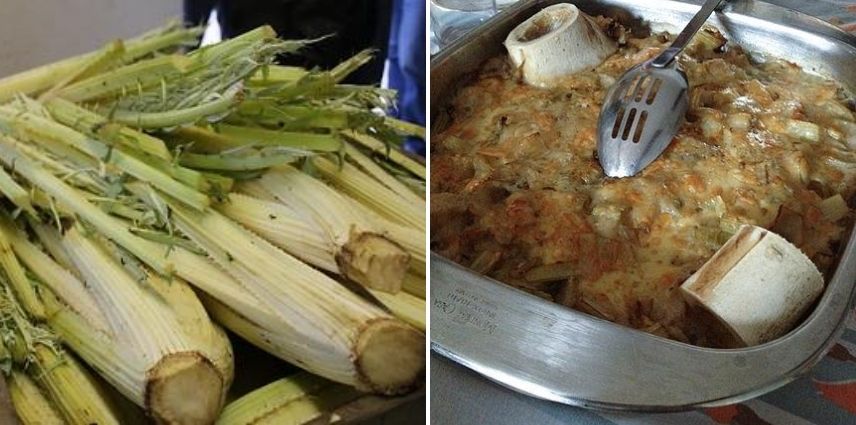
Cardoons ready to cook: the traditional Lyonnaise gratin elevates them! (Photo Xavier Caré-Wikimedia Commons)
Benefits
Low in calories (15/100g), the cardoon is a good ally in a weight-loss diet. The cardoon is an interesting source of vitamin C, fibre, minerals, and trace elements (magnesium and calcium, potassium). The cynarin it contains (a compound that gives it its bitterness) provides it with purifying properties, making it an excellent ally for the liver. It also contains inulin, a sugar tolerated by diabetics.
Associating the cardoon with the garden or vegetable patch
With its ample development, it is not always easy to associate the cardoon with the vegetable garden. In companion planting, however, it seems to appreciate the proximity of legumes such as broad beans, beans, and peas that enrich the soil with nitrogen after their harvest. It also thrives alongside cabbages, leeks, and vegetables with a shorter growing cycle, such as spinach, radishes, or salads that can be easily interspersed.
It would be a shame to confine it to the vegetable garden: its mere presence adds a highly sought-after architectural touch to the ornamental garden. With its very graphic appearance, the cardoon brings flair, volume, and contrast to borders of perennials or shorter annuals.
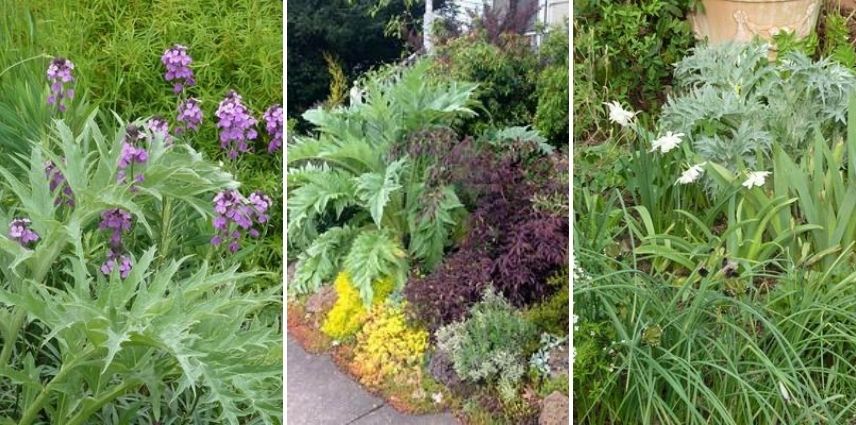
Cardoons create very interesting focal points in borders, associated with a palette of white, blue, or purple
To compose a rather exotic summer scene, place it in the background of a rose border or alongside a multitude of sun-loving perennials like itself, such as echinaceas, giant sea hollies, Kniphofia, daylilies, or even lilies. This opulent vegetable plant pairs very well with lighter foliage plants like grasses, with which it will create a lovely contrast in shape.
Finally, it will serve as a spectacular focal point when isolated on a lawn or at the edges of the house.
Useful resources
- Discover our collection of cardoon seeds!
- Find out how to blanch cardoons
- Neglected and then completely fallen from grace, some heritage vegetables are making a comeback in our gardens, rediscover them!
- Subscribe!
- Contents
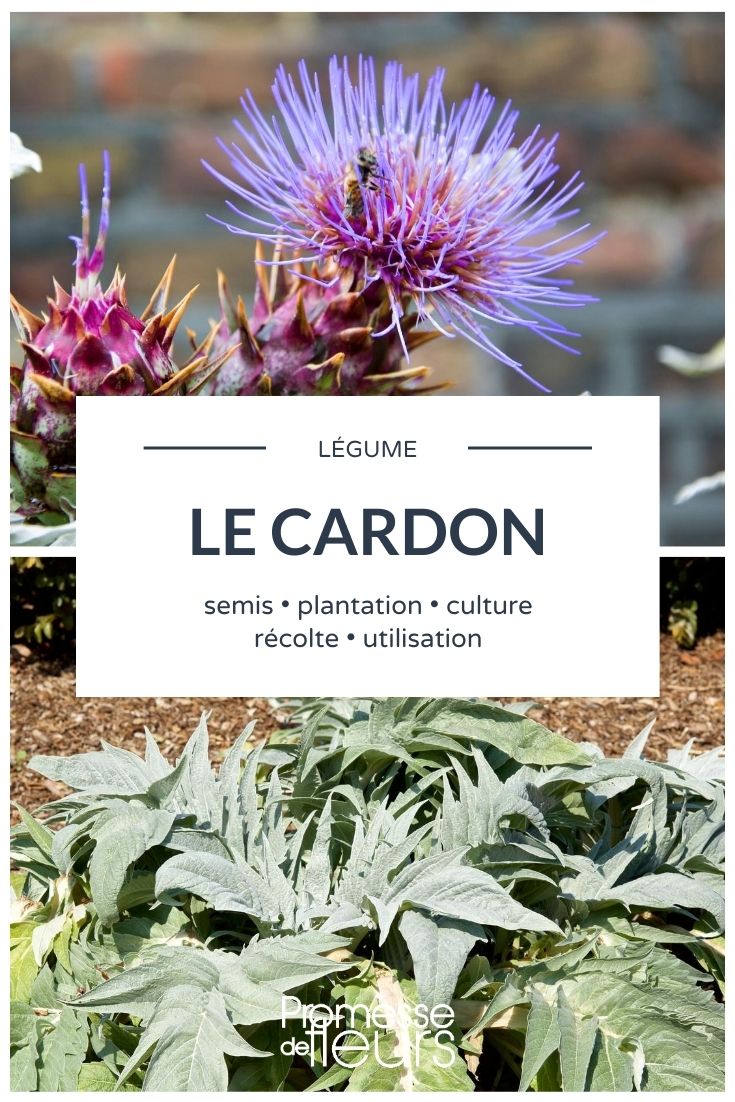


































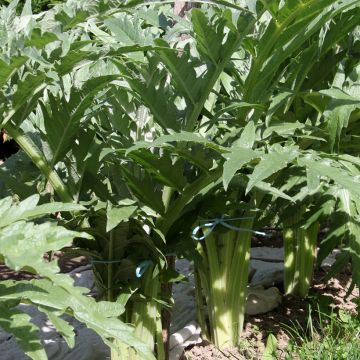
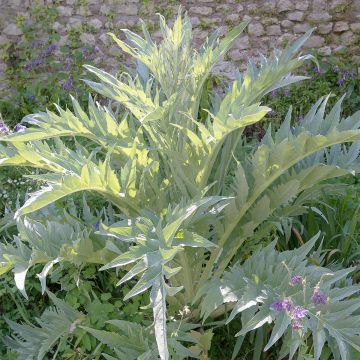
Comments